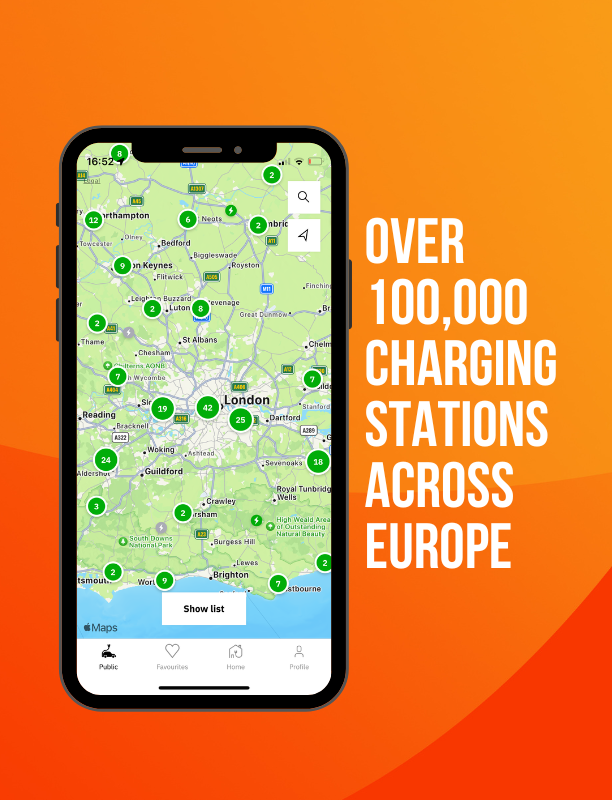Dinosaur Discovery Trail - Europe's Fossil Kingdom explored by EV
Imagine your children placing their hands inside 125-million-year-old dinosaur footprints while professional paleontologists teach them to identify ancient predator tracks from massive herbivore trails. Europe's Dinosaur Discovery Trail delivers exactly this magical fusion of scientific education and family adventure, guiding curious explorers aged 7-14 through authentic fossil sites where Jurassic giants once roamed.
Discover why Europe’s spectacular paleontological sites offer the perfect scientific adventure for families, combining hands-on fossil excavation, dinosaur track casting, and authentic paleontology workshops—all accessible through Europe’s comprehensive EV charging network.
Europe’s Dinosaur Discovery Trail presents families with children aged 7-14 the ultimate fusion of scientific discovery and adventure, where 150-million-year-old fossils come alive through interactive excavations, professional paleontologists guide authentic fossil preparation workshops, and children master scientific methodology while exploring some of the world’s most significant dinosaur discoveries. This comprehensive route from Berlin to Teruel via Bordeaux transforms passive museum visits into active paleontological participation through Europe’s most sophisticated family-friendly fossil programmes.
But what makes this prehistoric journey particularly exciting for modern families travelling by electric vehicle? Europe’s ambitious EV infrastructure expansion, with Germany’s 60,000+ charging points, France’s comprehensive autostrada network, and Spain’s rapidly developing fossil site access, has transformed the classic Central European Fossil Route into the continent’s most accessible paleontological adventure for eco-conscious families.
From hands-on fossil preparation in Berlin’s world-renowned Museum für Naturkunde to authentic excavation participation in Spain’s active dig sites, every educational moment is enhanced by sustainable travel that teaches children environmental responsibility alongside earth sciences—creating a comprehensive learning experience spanning 250 million years of prehistoric life.
Why Germany to Spain Defines Family Paleontological Education
The Dinosaur Discovery Trail offers families an unparalleled opportunity to experience authentic scientific methodology across multiple geological periods and fossil types, creating educational adventures that satisfy curious 7-year-olds fascinated by massive dinosaur skeletons alongside analytical 14-year-olds studying fossilisation processes and evolutionary theory.
Scientific Depth Across Ages: Unlike theme park dinosaur experiences targeting narrow age ranges, Europe’s paleontological sites naturally layer learning opportunities. Seven-year-olds can participate in fossil casting workshops while their teenage siblings learn about geological timelines through Jurassic limestone formations in Bavaria and Cretaceous trackways in Teruel.
Hands-On Scientific Learning: Europe’s family paleontology programmes emphasise active scientific participation over passive observation. Children use authentic paleontological tools, participate in real fossil preparation, engage in controlled excavations, and learn period-appropriate scientific methodology—creating tangible connections to prehistoric life impossible through textbooks alone.
Modern Infrastructure Supporting Ancient Discovery: Europe’s comprehensive EV infrastructure investment ensures families can explore 150-million-year-old fossils using 21st-century sustainable technology. The A9 Autobahn-A7 Autoroute-AP2 Autopista corridor from Berlin to Teruel now features charging stations every 40-50 kilometres, making the 1,800-kilometre journey comfortable for all EV models while teaching children about technological progress and environmental stewardship.
The Ultimate Dinosaur Discovery Route: Scientific Adventure Planning
Germany - European Dinosaur Capital (4-5 Days)
Base Location: Berlin / München | Educational Focus: Paleontological methodology, Jurassic ecosystems, fossil preparation techniques
Germany provides the perfect introduction to European paleontology, offering families world-class dinosaur specimens, hands-on fossil workshops, and authentic scientific experiences designed specifically for children aged 7-14.
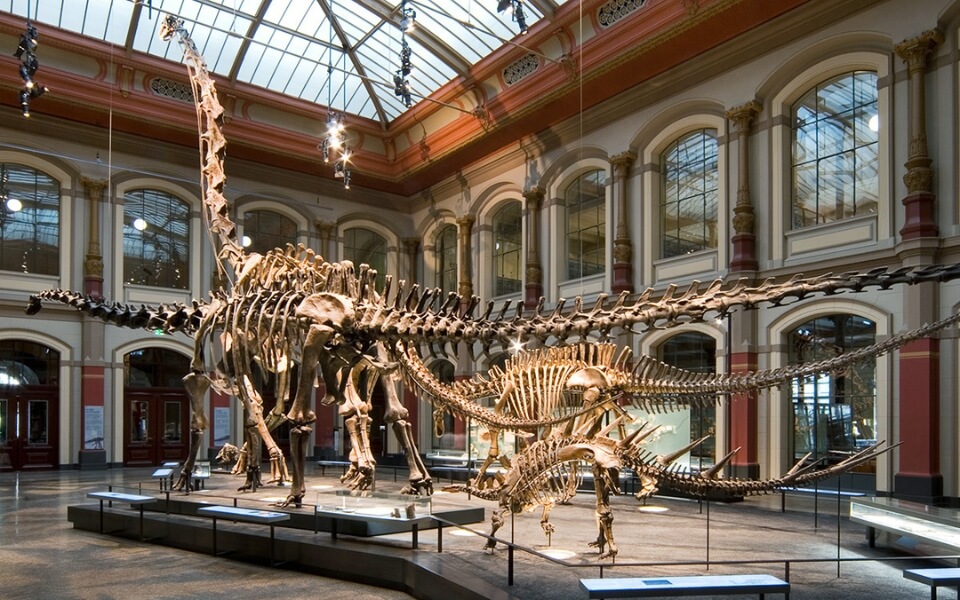 Natural History Museum Berlin
Natural History Museum Berlin
Museum für Naturkunde Berlin: World’s Tallest Dinosaur
The Museum für Naturkunde houses the world’s largest mounted dinosaur skeleton—the spectacular 13.27-metre-tall Brachiosaurus alongside comprehensive Paleontology Workshop Programme perfectly designed for children aged 7-14. Young paleontologists learn authentic fossil preparation techniques using professional pneumatic tools and fine brushes under qualified scientific supervision with specialized family education training. The 3-hour “Junior Paleontologist” experience includes real fossil cleaning, geological timeline education, and extinction event understanding through hands-on scientific methodology. Upon successful completion, each child receives an official paleontologist certificate and prepared fossil specimen, creating tangible mementos of their journey into prehistoric scientific discovery.
EV Convenience: Central Berlin features over 1,200 charging points within 5 kilometres of the museum, with Potsdamer Platz offering ultra-fast charging perfectly timed for the 3-hour workshop experience.
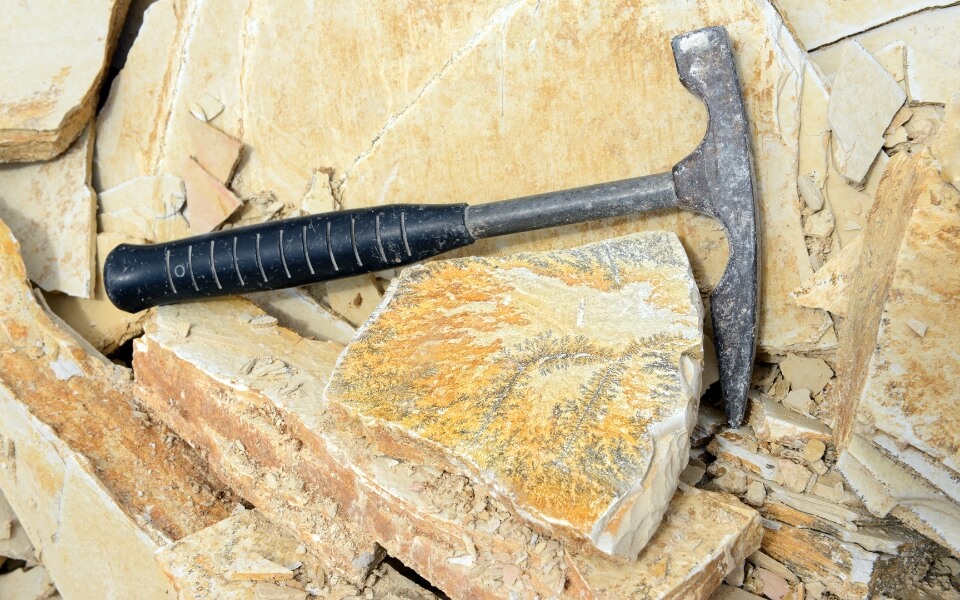 Solnhofen Limestone Quarries
Solnhofen Limestone Quarries
Solnhofen Limestone Quarries: Archaeopteryx Homeland
This world-famous Jurassic limestone region offers families authentic fossil hunting experiences where children aged 8-14 can discover genuine 150-million-year-old specimens under professional paleontological guidance. The Bürgermeister-Müller-Museum Solnhofen provides family fossil hunting tours featuring safe quarry exploration, fossil identification workshops, and hands-on geological education about the Solnhofen Formation—home to the world’s most spectacular Archaeopteryx specimens and prehistoric marine life. Family packages include professional fossil hunting equipment, safety gear, and expert geological interpretation ensuring both educational value and practical fossil discovery success.
Family Strategy: Book morning fossil hunting sessions (9:00 AM start) for optimal fossil visibility and comfortable working conditions before afternoon heat affects concentration.
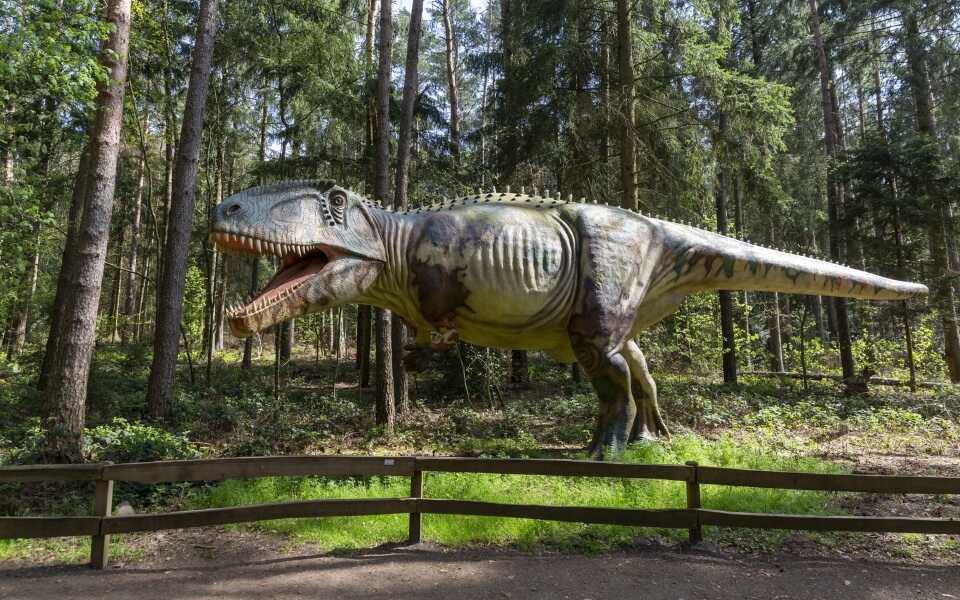 Münchehagen Dinosaur Park
Münchehagen Dinosaur Park
Münchehagen Dinosaur Park: Germany’s Authentic Trackway Treasure
This exceptional site combines authentic 139-million-year-old dinosaur footprints with comprehensive family education programmes. Over 300 fossilized footprints from three distinct dinosaur species are preserved under protective glass, including massive sauropod tracks similar to Diplodocus, ornithopod footprints likely from Iguanodon, and three-toed theropod tracks from predators similar to Allosaurus. The tracks were discovered during firefighter training exercises and represent muddy tropical lagoon conditions from the Early Cretaceous period.
Educational Value: Children learn authentic ichnology (track science) while observing genuine prehistoric evidence, understanding preservation processes and paleoenvironmental reconstruction. The site includes hands-on fossil preparation workshops, excavation simulations, and trackway analysis training that teach scientific methodology through real dinosaur discoveries. Declared a German National Geotope in 2006, this represents one of Europe’s most significant in-situ trackway preservation sites.
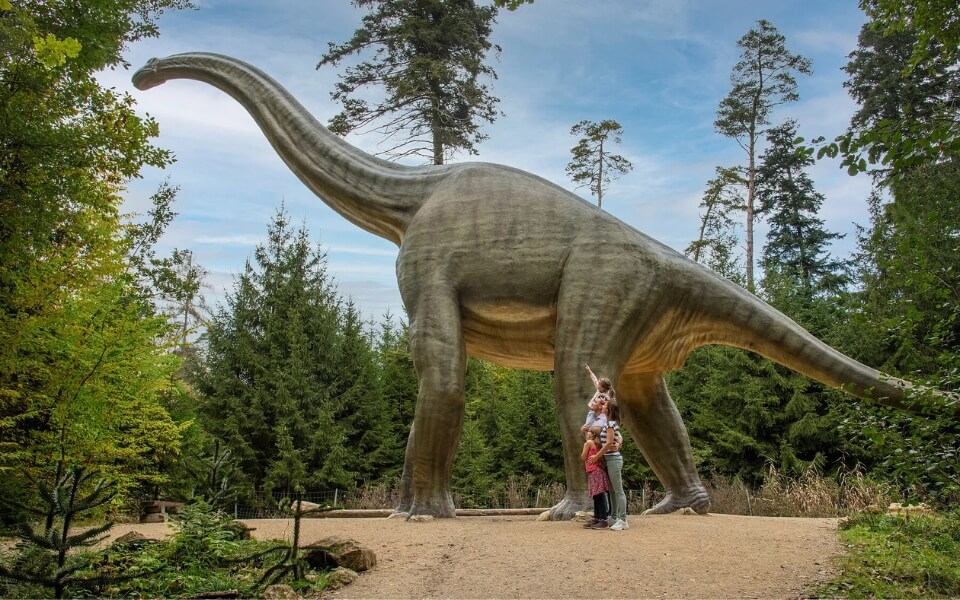 Altmühltal Dinosaur Museum
Altmühltal Dinosaur Museum
Altmühltal Dinosaur Museum: Bavarian Fossil Treasures
Located in Denkendorf, this specialized museum offers hands-on paleontological workshops where families engage with authentic Jurassic specimens from local excavations. The “Fossil Detective” programme teaches children scientific observation techniques, geological formation understanding, and comparative anatomy through interactive displays and touchable specimens. Advanced workshops for 11-14 year olds include fossil casting, geological map reading, and evolutionary timeline construction using regional paleontological evidence from the Franconian Alb. All participants receive field notebooks and geological tools for continued exploration.
France - Cave Art & Prehistoric Ecosystems (3-4 Days)
Distance from Germany: 800 kilometres | Driving Time: 8-9 hours via A6-A89 | EV Range Required: Two charging stops Educational Focus: Prehistoric art, human-dinosaur timeline understanding, fossilisation processes
France serves as the cultural and educational bridge between Germany’s systematic paleontology and Spain’s spectacular excavation experiences, offering families world-class cave art and comprehensive fossil education programmes.
 Musée des Dinosaures Espéraza
Musée des Dinosaures Espéraza
Musée des Dinosaures Espéraza: Pyrenean Fossil Laboratory
This specialized dinosaur museum in the Aude Valley offers 2-3 hours of immersive paleontological exploration featuring original French dinosaur discoveries and hands-on fossil preparation laboratories. Families engage with interactive multimedia guides specifically designed for 7-14 age groups, while participating in fossil cleaning sessions, casting technique demonstrations, and geological formation explanations that provide comprehensive understanding of European dinosaur ecosystems. Professional paleontologists conduct family-focused workshops including Cretaceous period education and regional extinction event studies using actual specimens from Haute-Vallée de l’Aude excavations.
Comprehensive Educational Workshops:
These authentic scientific experiences include fossil preparation using professional pneumatic tools and precision instruments, geological timeline construction through stratigraphic layer analysis, and comparative anatomy workshops studying European vs. American dinosaur species. Advanced programmes feature fossilisation process education including permineralisation demonstrations, trace fossil analysis of dinosaur trackways and coprolites, and paleoecology reconstruction understanding how Cretaceous ecosystems functioned across southern France. All activities culminate in scientific documentation training where families create professional-style fossil reports following authentic paleontological methodology.
EV Infrastructure Excellence: The Aude Valley features comprehensive charging infrastructure designed for paleontological tourism, with fast-charging stations in Limoux and Quillan serving museum visitors and fossil site explorers.
Strategic Charging Locations:
- Carcassonne Centre: Multiple 150kW charging points perfect for overnight stops and medieval exploration
- Limoux Historic Centre: Urban charging ideal for museum visits and family dining
- Quillan Tourist Area: Charging stations with mountain views during fossil workshop sessions
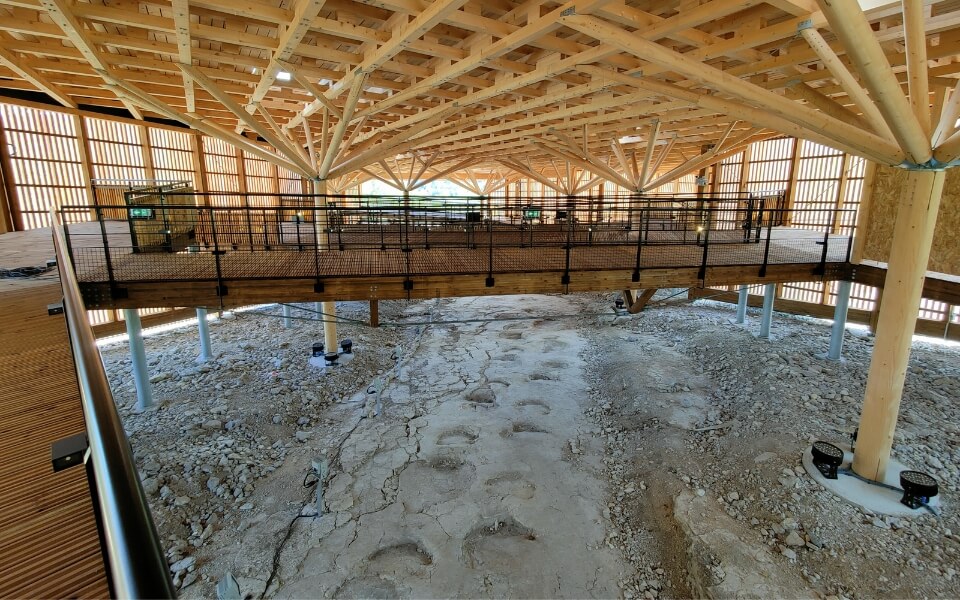 Dinoplagne
Dinoplagne
Dinoplagne: World’s Longest Dinosaur Trackway
Located in the Jura Mountains near Lyon, Dinoplagne protects the world’s longest sauropod trackway at 155 metres with 110 individual footsteps dating 150 million years to the Late Jurassic period. This extraordinary site, discovered in 2009, reveals the journey of a 35-metre-long sauropod weighing 35-40 tonnes that walked at 4 km/h across ancient mudflats. Family visits include virtual reality experiences transporting children back 150 million years to observe Jurassic ecosystems, guided trail walks explaining geological formation, and interactive educational programmes about dinosaur behavior and environmental change.
Scientific Significance: Footprint analysis reveals five elliptical toe marks on rear feet and five circular finger marks on front feet, with individual tracks spanning up to 1.03 metres. The trackway direction and stride consistency suggest purposeful migration rather than random wandering, providing unprecedented insight into sauropod social behavior and long-distance movement patterns. Additional theropod trackways at the site include 18 tracks from Megalosauripus spanning 38 metres, demonstrating predator-prey relationships in Jurassic France.
Family Activities: Dinoplagne offers connected trail experiences with smartphone apps providing augmented reality dinosaur reconstruction, geological timeline education, and biodiversity comparisons between Jurassic and modern ecosystems. Virtual reality headsets allow children to experience authentic Jurassic environments while standing on the exact location where dinosaurs walked 150 million years ago.
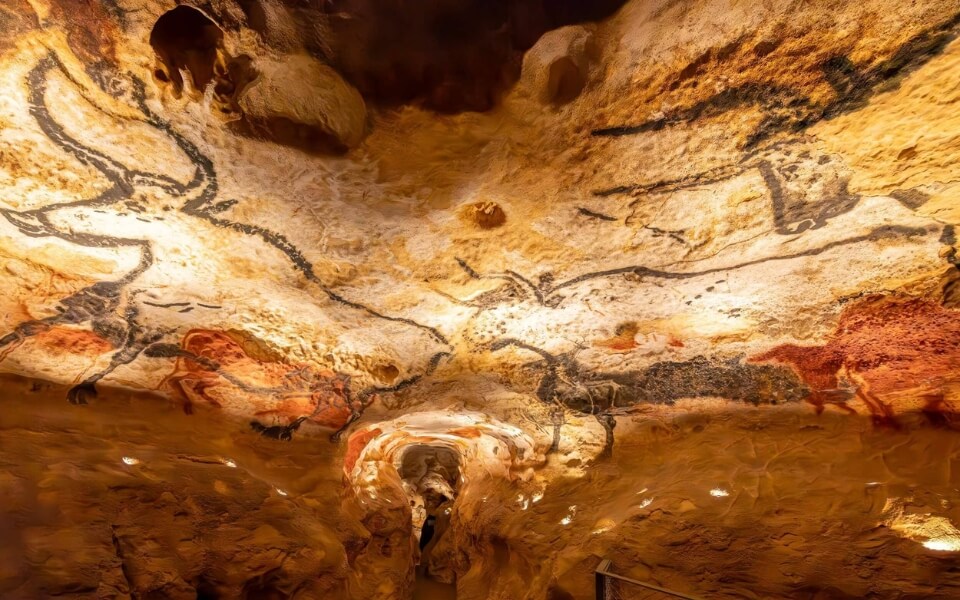 Lascaux IV Centre International
Lascaux IV Centre International
Lascaux IV Centre International: Prehistoric Art Masterpiece
While primarily focused on cave art, Lascaux IV provides essential context for understanding human relationships with extinct megafauna including cave bears, woolly mammoths, and cave lions. The 90-minute family experience combines prehistoric art appreciation with extinction event education, helping children understand geological timelines and species evolution. Interactive workshops allow families to create cave art using natural pigments while learning about Pleistocene ecosystems and human adaptation during Ice Age periods. This provides crucial timeline context connecting dinosaur extinction with human evolution and modern conservation challenges.
Spain - Mediterranean Dinosaur Paradise (4-5 Days)
Distance from France: 600 kilometres | Duration: 6-7 hours via A9-AP7-A23 | EV Range Required: Two strategic charging stops Educational Focus: Active excavation participation, dinosaur trackways, marine reptile fossils
Spain offers families the ultimate hands-on paleontological experience, where children aged 7-14 can participate in actual excavation sites, learn advanced fossil preparation, and explore Europe’s most spectacular dinosaur discoveries.
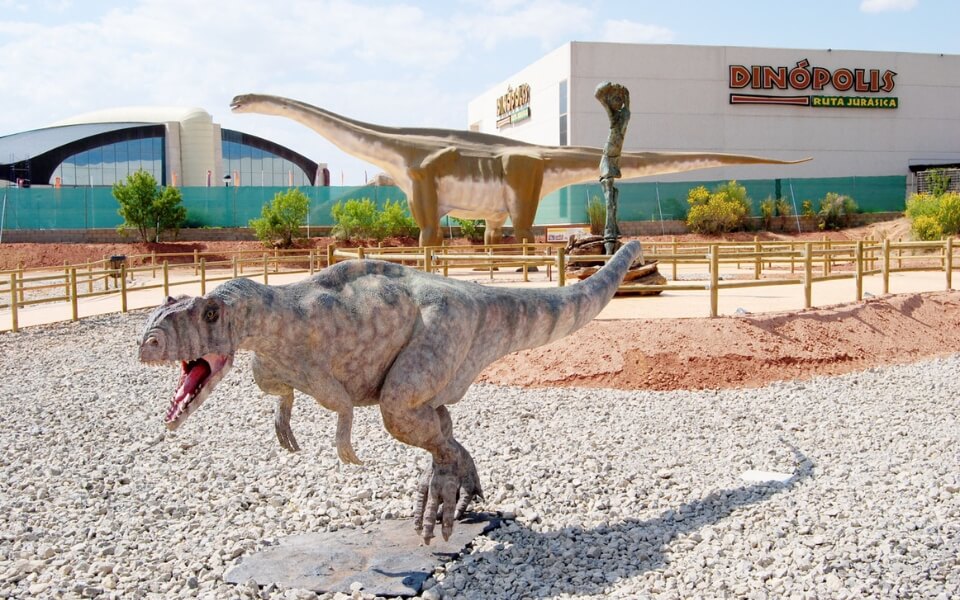 Dinópolis Teruel
Dinópolis Teruel
Dinópolis Teruel: Europe’s Premier Paleontological Park
Dinópolis represents Europe’s most comprehensive dinosaur education centre, offering families full-day experiences featuring authentic excavation participation, fossil preparation workshops, and paleontological methodology training under the guidance of qualified scientists specializing in family education. The park provides age-appropriate programmes for 7-10 and 11-14 year groups, ensuring scientific complexity matches developmental stages. All participants receive professional paleontological equipment, safety gear, and field documentation materials, achieving educational outcomes including scientific observation skills, geological formation understanding, and evolutionary theory comprehension through hands-on participation in authentic paleontological research following international scientific standards.
Advanced Scientific Experiences:
These sophisticated programmes include controlled excavation simulation on prepared sites containing authentic fossil replicas, stratigraphic documentation learning how geological layers reveal prehistoric timelines, and specimen cataloguing using professional database techniques employed in real paleontological research. Participants explore fossilisation processes through permineralisation experiments, trace fossil analysis of dinosaur trackways and nesting sites, and comparative osteology studying bone structure differences between herbivorous and carnivorous species that inhabited Cretaceous Spain 125 million years ago.
Professional Research Participation:
For families seeking advanced engagement, Dinópolis offers research collaboration opportunities including 3D fossil scanning using photogrammetry techniques employed in modern paleontology, geological mapping of Teruel Formation outcrops where Turiasaurus riodevensis—Europe’s largest dinosaur—was discovered, and scientific presentation training where families document discoveries and present findings to other participants using professional paleontological standards and peer-review methodology.
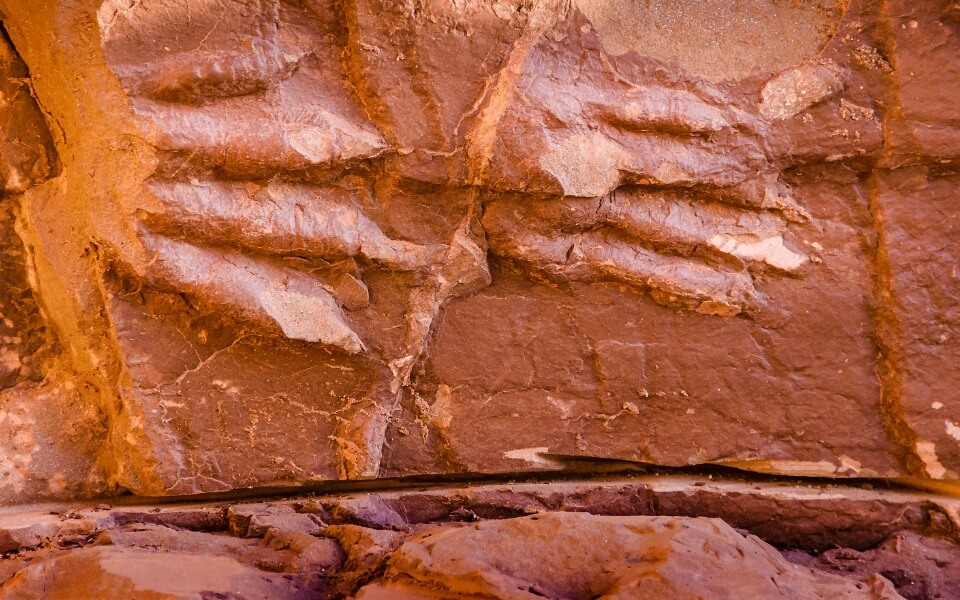 La Rioja Paleontological Centre
La Rioja Paleontological Centre
Real Dinosaur Trackway Sites: Walking Where Giants Walked
The Dinópolis territory and La Rioja region contain Europe’s most spectacular authentic dinosaur trackway sites where families can walk alongside 125-million-year-old footprints preserved in Cretaceous limestone. Enciso’s Dinosaur Trail features nearly 2,000 individual tracks from multiple species outlined in white paint for enhanced visibility, while Era del Peladillo offers the densest concentration of sauropod, theropod, and ornithopod footprints in Europe.
Professional ichnology tours teach children trace fossil science, gait analysis for determining dinosaur behavior and speed calculations, and environmental reconstruction understanding how ancient ecosystems functioned through trackway evidence. Hands-on activities include plaster casting of genuine 125-million-year-old footprints, stride measurement and speed calculations revealing that some Spanish theropods reached speeds of 25-30 km/h, and behavioral interpretation determining whether trackways represent hunting patterns, seasonal migration, or social group movement across ancient mudflats.
Advanced Trackway Experiences: La Rioja Paleontological Centre in Igea provides family workshops where children learn to identify different dinosaur species from footprint characteristics, understand preservation processes that created these 150-million-year-old time capsules, and participate in digital documentation using photogrammetry techniques employed by professional paleontologists to create 3D models of trackway discoveries.
Hidden Paleontological Treasures: Off-the-Beaten-Path Family Discoveries
Secret Fossil Sites: Beyond the Tourist Trail
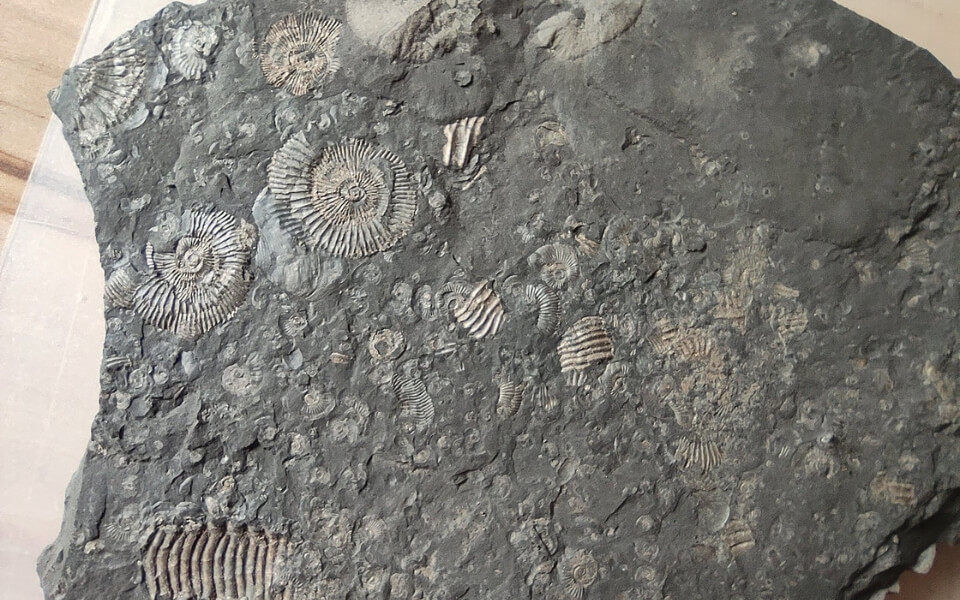 Holzmaden Fossil Quarry
Holzmaden Fossil Quarry
Holzmaden Fossil Quarry: Jurassic Marine Paradise
This extraordinary Swabian Alb location reveals 180-million-year-old marine reptiles preserved in exceptional detail within Posidonia Shale formations. Families discover complete ichthyosaur skeletons, plesiosaur specimens, and ancient crinoid gardens while learning about Jurassic marine ecosystems. Children aged 8-14 participate in controlled fossil collection under professional geological supervision, with each family receiving authentic specimens for home study. The 2-hour guided experience includes geological formation education, marine reptile biology, and environmental change understanding how ancient oceans differed from modern seas.
Grès à Voltzia Formations: Triassic Time Capsule
Located in France’s Vosges Mountains, these 240-million-year-old formations contain spectacular plant fossils and early reptile remains from the Triassic period—before dinosaurs dominated Earth. Family geological walks reveal ancient conifer forests, primitive amphibian tracks, and early archosaur fossils that represent dinosaur ancestors. Educational workshops teach evolutionary progression from Permian extinction through Triassic recovery to Jurassic dinosaur radiation, providing comprehensive understanding of life’s resilience and evolutionary adaptation through hands-on fossil discovery and geological observation.
Coastal Dinosaur Highways: Spain’s Spectacular Shore Trackways
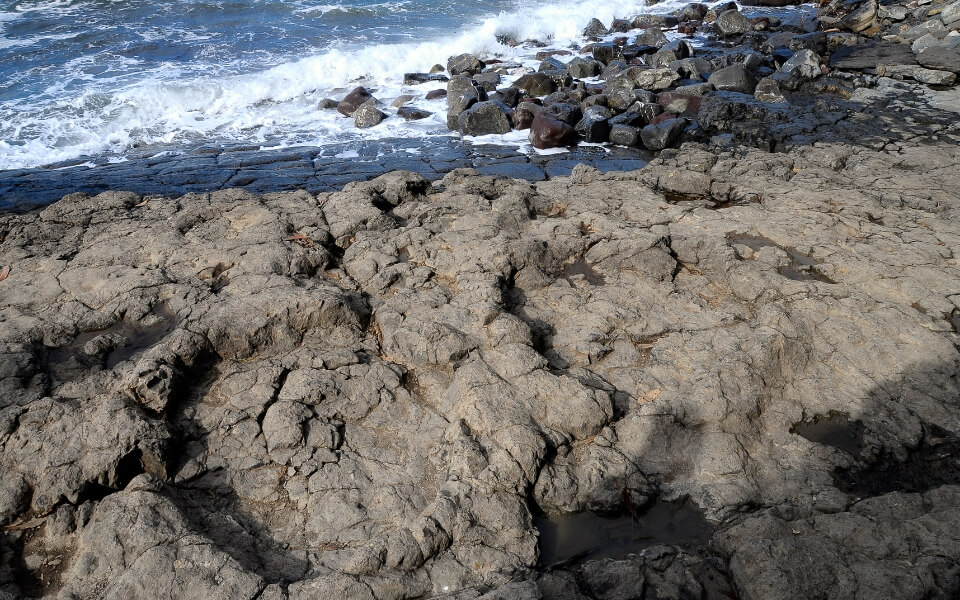 Asturias Dinosaur Coast
Asturias Dinosaur Coast
Asturias Dinosaur Coast: Beach Trackway Paradise
The northern Spanish coast from Gijón to Ribadesella contains Europe’s most spectacular coastal dinosaur trackways preserved on wave-cut platforms and cliff faces. La Griega Beach near Colunga features some of the world’s largest sauropod footprints alongside theropod, ornithopod, and rare Stegosaurus tracks dating 140-160 million years to the Late Jurassic period. Family exploration combines beach hiking with paleontological discovery, while tide-dependent access creates natural scheduling for educational programmes and coastal safety awareness.
Unique Trackway Features:
The Asturias trackways preserve exceptional behavioral evidence including parallel sauropod tracks suggesting herd movement, theropod hunting patterns following herbivore routes, and environmental adaptation to coastal ecosystems. MUJA (Jurassic Museum of Asturias) provides comprehensive preparation with site-specific guides, tide table education, and coastal geology workshops that enhance trackway appreciation through scientific understanding of preservation processes and marine erosion effects.
Professional Guided Expeditions:
Universidad de Oviedo paleontologists offer family-friendly coastal tours teaching ichnology principles, trace fossil identification, and paleoenvironmental reconstruction through hands-on trackway analysis. Educational outcomes include understanding tidal effects on fossil preservation, recognizing different dinosaur gaits, and appreciating coastal erosion as both destructive and revealing force in paleontological discovery.
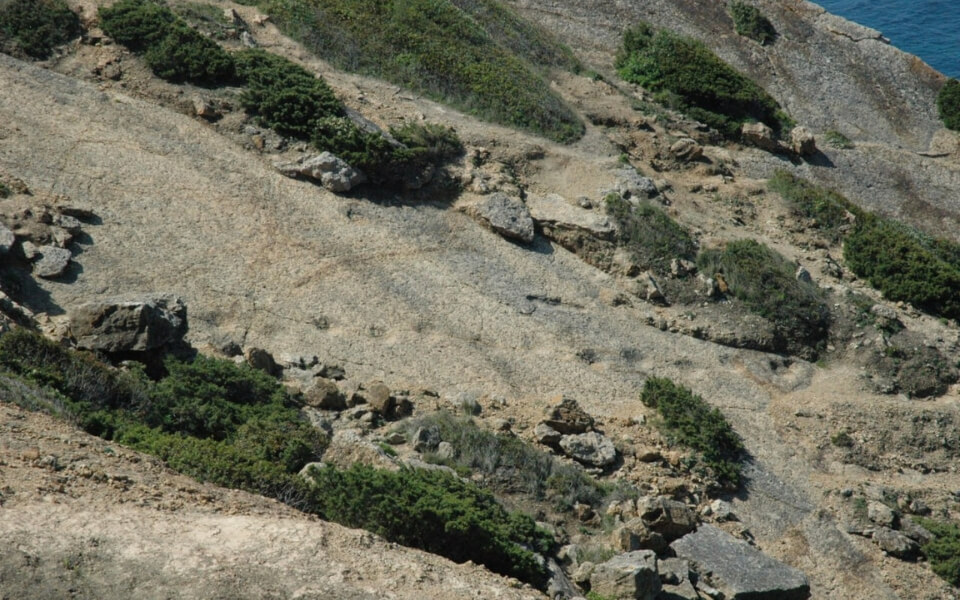 Cabo Espichel Dinosaur Tracks
Cabo Espichel Dinosaur Tracks
Cabo Espichel Dinosaur Tracks: Portuguese Border Discovery
Just accessible from eastern Spain, this spectacular coastal site features 155-million-year-old sauropod trackways preserved in limestone cliffs overlooking the Atlantic Ocean. Families explore dinosaur highways where massive long-necked dinosaurs migrated along ancient coastlines, with trackway analysis revealing social behavior, herd structure, and seasonal movement patterns. Guided expeditions include coastal geology education, marine fossil identification, and paleogeography understanding how Jurassic Iberia differed from modern landscapes.
Geological Adventure Activities:
These unique experiences combine coastal exploration with paleontological education through tide pool investigation revealing modern marine life for comparison with Jurassic marine reptiles, cliff geology analysis showing sedimentary formation processes, and environmental change education demonstrating how sea level fluctuations affect fossil preservation and trackway exposure over millions of years.
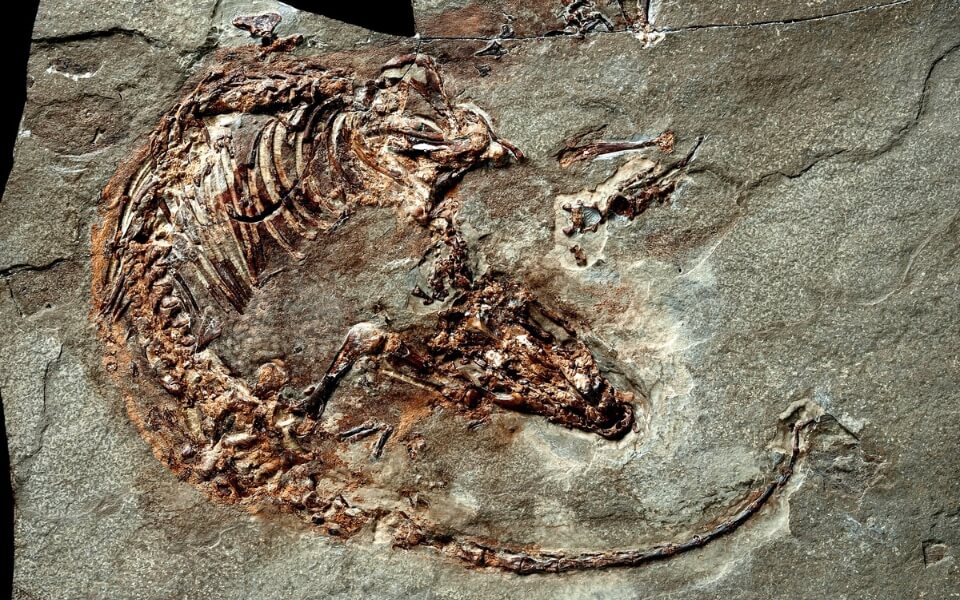 Las Hoyas Fossil Site
Las Hoyas Fossil Site
Las Hoyas Fossil Site: Cretaceous Lagoon Ecosystem
This world-renowned 125-million-year-old locality near Cuenca offers families access to exceptional preservation including dinosaur skin impressions, prehistoric bird feathers, and complete insect specimens. Professional paleontological tours reveal ancient lagoon ecosystems where early birds, pterosaurs, and small dinosaurs lived alongside primitive flowering plants and diverse invertebrates. Family workshops include ecological reconstruction, food web analysis, and preservation process understanding through exceptional fossil specimens that provide snapshot views of Cretaceous life.
Alpine Fossil Adventures: Mountain Paleontology
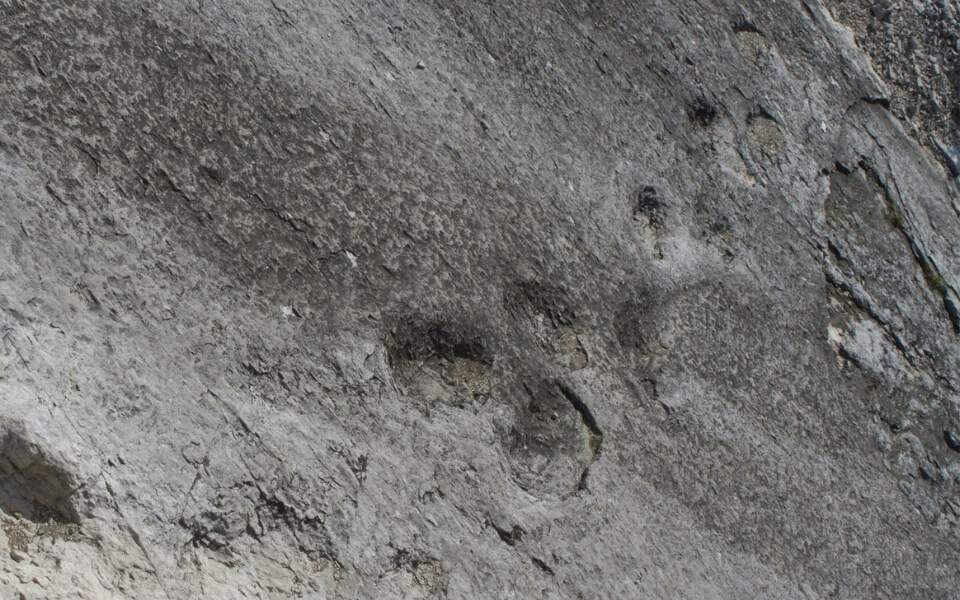 Dolomites Fossil Trails
Dolomites Fossil Trails
Dolomites Fossil Trails: Triassic Marine Giants
The Italian Dolomites (accessible from eastern Spain via excellent EV infrastructure) contain spectacular marine reptile fossils and coral reef systems from 240 million years ago. Family hiking expeditions combine mountain scenery with fossil discovery, revealing nothosaur skeletons, ancient coral atolls, and Triassic marine ecosystems preserved at 2,000-metre altitude. Educational programmes include mountain geology, tectonic uplift understanding how ancient sea floors became modern mountains, and environmental change education spanning geological timescales.
Scientific Mountain Adventures: These unique programmes feature high-altitude fossil collection under professional supervision, geological formation mapping using GPS technology and professional geological tools, climate change education comparing ancient tropical seas with modern alpine environments, and conservation awareness understanding how mountain ecosystems preserve prehistoric evidence while supporting modern biodiversity requiring careful environmental protection and sustainable tourism practices.
Underground Fossil Mysteries: Cave Paleontology
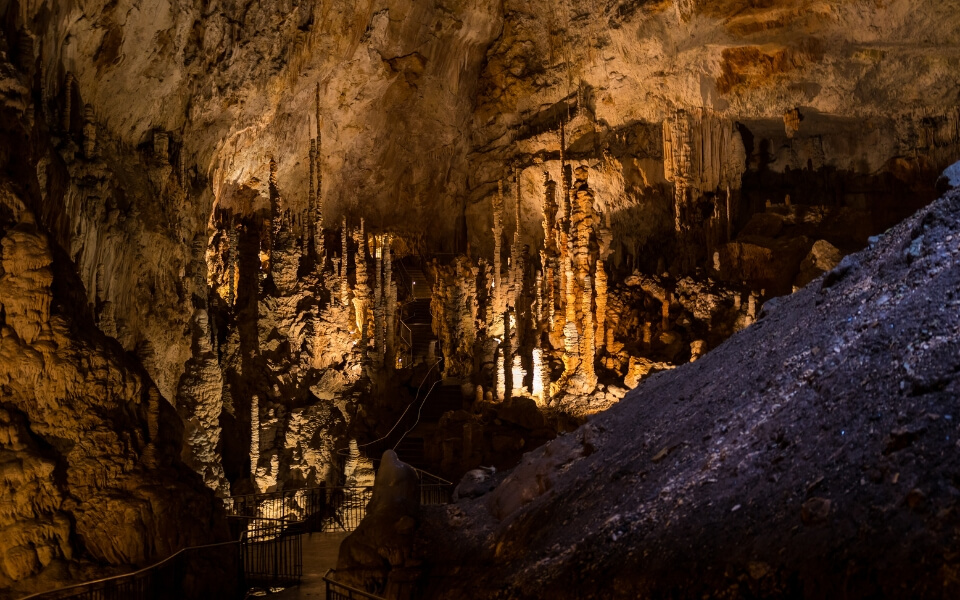 Aven d’Orgnac
Aven d’Orgnac
Aven d’Orgnac: Subterranean Fossil Cathedral
This spectacular limestone cave system in southern France contains exceptional fossil preservation including cave bear remains, Pleistocene fauna, and speleothem formations preserving ancient climate data. Family cave expeditions combine underground exploration with paleontological education, revealing how caves preserve paleontological evidence over millions of years. Educational activities include cave formation geology, fossil preservation in limestone environments, and climate history recorded in stalactite growth rings and sediment layers.
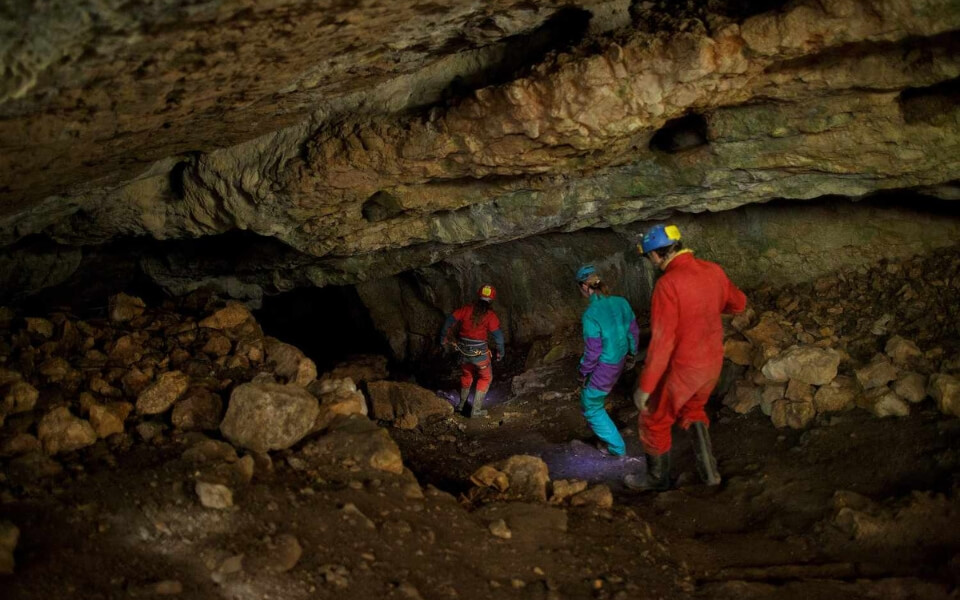 Sima de los Huesos
Sima de los Huesos
Sima de los Huesos: Human Evolution Context
While primarily an early human site, Burgos’s world-famous paleontological complex provides essential context for understanding mammalian evolution during Pleistocene periods. Family educational tours explore bear caves, hyena dens, and ancient carnivore ecosystems that coexisted with early humans, teaching ecological relationships and evolutionary adaptation through exceptional fossil preservation in mountain cave systems.
Seasonal Planning: When to Discover Europe’s Fossil Kingdom
Spring (March-May): The Golden Paleontological Season
Why Spring Excels for Family Fossil Exploration: Spring offers families ideal combination of mild temperatures (12-20°C), extended daylight hours, and reduced tourist crowds that make outdoor excavation comfortable for children aged 7-14. Easter holidays coincide perfectly with European museum special programmes, when many paleontological sites offer exclusive family workshops and hands-on activities unavailable during other periods.
EV Advantages in Spring Weather: Moderate temperatures optimise battery performance, delivering 8-12% better range compared to summer heat stress or winter cold affecting EV systems. Pre-conditioning requirements remain minimal, and regenerative braking performs excellently on Alpine approaches and Pyrenean mountain routes without weather-related efficiency loss.
Educational Highlights:
- Solnhofen quarries feature optimal fossil visibility after winter erosion exposes new specimens
- Outdoor excavation sites remain comfortable for extended family participation sessions
- Cave exploration at perfect temperatures for children’s concentration and safety
Spring EV Charging Strategy: Reduced heating/cooling usage means charging sessions can be 20-25% shorter, allowing maximum time for fossil preparation workshops and excavation activities.
Early Autumn (September-October): Fossil Festival Season
Cultural Event Integration: Autumn brings European Heritage Days and Science Festival weeks, offering families free or reduced-price access to normally expensive paleontological sites and exclusive behind-the-scenes experiences. Harvest season in wine regions provides cultural experiences combining geological education about vineyard terroir with fossil site exploration during perfect weather conditions.
Optimal EV Performance Period: September-October delivers peak EV efficiency with comfortable temperatures, minimal battery stress, and excellent regenerative braking performance on mountain approaches to Alpine fossil sites and Pyrenean dinosaur locations.
Weather Benefits for Paleontological Exploration:
- Clear skies perfect for outdoor excavation workshops and geological observation
- Stable weather ideal for multi-day fossil preparation programmes
- Reduced precipitation ensuring quarry access and cave exploration remain available
Winter Considerations (November-February): Indoor Laboratory Focus
Indoor Scientific Advantages: Winter shifts family focus to Europe’s extraordinary indoor paleontological experiences: Berlin’s Museum für Naturkunde (perfect for detailed fossil study), preparation laboratories in France, and advanced workshops in Spain’s climate-controlled facilities. Many fossil preparation labs and research centres offer extended programmes during winter months when outdoor excavation becomes impractical.
EV Winter Management: European winter temperatures (-5 to 10°C) require pre-conditioning strategies but remain within acceptable EV performance ranges. Indoor charging at family-friendly accommodations becomes essential, making hotel selection crucial for maintaining charging convenience and battery performance during cold weather periods.
Advanced Educational Workshop Season: Winter provides optimal timing for intensive fossil preparation, microscopic analysis workshops, geological timeline education, and comparative osteology studies requiring laboratory conditions and extended concentration periods that outdoor excavation cannot provide during active digging seasons.
Advanced EV Battery Management for Fossil Route Exploration
Alpine and Pyrenean Approaches: Mountain EV Strategy
Mountain Driving for Fossil Sites: European fossil locations often require mountain approaches to geological formations and quarry sites. Pyrenean routes to Spanish dinosaur sites and Alpine approaches to Italian marine reptile locations provide excellent opportunities for regenerative braking optimisation, potentially recovering 20-30% of energy used during mountain ascents. Dolomites fossil sites and French mountain formations offer families practical experience with EV mountain driving while accessing spectacular geological outcrops.
Practical Mountain Navigation:
- Approach Dinópolis via A23 Autovia for optimal battery management and charging infrastructure
- Pyrenean fossil sites accessible through A64-A8 corridor with strategic charging planning
- Alpine marine reptile locations via comprehensive charging networks throughout northern Italy
Long-Distance EV Strategy: Multi-Country Fossil Trail
Cross-Border Route Optimisation: Charge to 95% before departing Germany for maximum family confidence during international travel with children. The 1,800-kilometre total journey requires strategic charging planning with comfortable reserves for urban exploration and unexpected fossil site detours upon arrival at each destination.
Multi-Country Charging Management: The easyCharging app provides seamless access across Germany, France, and Spain with unified billing and consistent service quality, eliminating payment complications and network compatibility concerns during international fossil exploration.
Fossil Site Access: Rural and Remote Charging
Remote Site Battery Planning: Many world-class fossil sites exist in rural locations requiring careful range management. Solnhofen quarries, Pyrenean formations, and Spanish excavation sites now feature dedicated EV charging for sustainable paleontological tourism, but planning remains essential for family peace of mind.
Rural Charging Strategy:
- Pre-charge to 100% before remote fossil site visits ensuring air conditioning availability during hot excavation sessions
- Identify backup charging within 30-kilometre radius of all planned fossil locations
- Combine charging with meal breaks and accommodation in fossil site regions
Practical Trackway Visiting: Timing and Access Strategy
Optimal Trackway Exploration Scheduling
Tidal Considerations for Coastal Sites: Asturias dinosaur beaches require low tide timing for optimal trackway visibility and safe family access. La Griega Beach and Tereñes locality tracks become fully visible during spring tides with optimal viewing windows 2-3 hours either side of low tide. MUJA museum provides monthly tide tables and weather-dependent access advice ensuring family safety and maximum educational value during coastal trackway exploration.
Weather-Dependent Site Access: Mountain trackway sites like Dinoplagne and La Rioja locations require clear weather for optimal visibility and safe trail access. Limestone trackways become slippery during rain, making dry conditions essential for family safety during authentic footprint exploration. Indoor alternatives like regional museums provide weather-independent education while waiting for optimal site conditions.
Advance Booking Requirements:
- Dinoplagne (France): Reservations essential, limited daily capacity, virtual reality experiences require additional booking
- La Rioja trackway tours: Advance booking recommended, guided tours fill quickly during peak season
- Münchehagen trackway area: Open access but educational programmes require advance registration
- Asturias coastal sites: Free access but guided tours need university programme booking
Summer Heat Management (June-August)
Extreme Temperature Fossil Site Access: European summer temperatures exceeding 35°C significantly impact both EV performance (15-20% range reduction) and children’s comfort during outdoor excavation activities. Spanish fossil sites and southern French quarries require careful scheduling and thermal management for both vehicle batteries and family safety.
Heat Mitigation Strategies: Schedule outdoor fossil hunting and excavation workshops for early morning hours (7:00-10:00 AM) when temperatures remain manageable and EV efficiency stays optimal. Pre-condition vehicles during overnight charging to reduce initial cooling energy consumption, and seek covered charging stations near fossil sites to prevent battery overheating during extended site visits.
Educational Activity Adaptation:
- Morning excavation sessions followed by afternoon museum visits with climate control
- Cave fossil sites providing natural cooling during peak heat periods
- Charging during hot periods while families enjoy air-conditioned preparation laboratories
Mountain Weather Fossil Exploration
Alpine and Pyrenean Considerations: Mountain fossil sites experience rapid weather changes requiring flexible planning and appropriate EV preparation. Altitude affects both EV range (reduced air density) and charging speeds (temperature variations), while mountain weather can change rapidly affecting fossil site access and family safety.
Mountain EV Optimisation: Pre-heat vehicles during valley charging before mountain ascents to reduce energy consumption during climbs to fossil sites. Monitor weather forecasts carefully, as mountain storms can affect visibility and road conditions while temperature drops impact battery performance and passenger comfort during extended outdoor geological exploration.
Flexible Mountain Planning:
- Alternative indoor sites prepared for sudden weather changes
- Valley charging stations identified for emergency returns from mountain fossil locations
- Weather monitoring apps essential for safe mountain fossil exploration with children
Budget Planning: Paleontological Education and EV Investment
Daily EV Charging Costs (Family of Four):
- German Urban Exploration: €18-28 daily (150-200km including rural fossil sites)
- International Journey: €45-65 per border-crossing day (including mountain routes and premium charging)
- Spanish Fossil Circuit: €15-25 daily (regional exploration and excavation site access)
Paleontological Experience Investment:
- Museum für Naturkunde Workshops: €35-55 per child (includes professional supervision, tools, certificate)
- Dinópolis Full Experience: €45-75 per person (includes excavation, preparation labs, scientific documentation)
- Solnhofen Fossil Hunting: €25-45 per child (includes equipment, geological guidance, specimen retention)
- Regional Museum Packages: €80-120 per family (multi-site access, workshop combinations, educational materials)
Money-Saving EV Strategies for Fossil Tourism:
- Geological Tourism Accommodation: Many fossil region hotels include EV charging and paleontological tour packages, saving €20-35 daily
- Charging During Activities: Laboratory sessions and preparation workshops align perfectly with EV charging schedules
- International Fossil Passes: Multi-country museum packages reduce individual site costs by 25-35%
- Off-Peak International Travel: Avoid summer holidays for 20-30% savings on accommodation, charging, and fossil tourism experiences
Your Prehistoric Legacy Adventure
The Dinosaur Discovery Trail represents the perfect fusion of prehistoric discovery and modern sustainable travel, creating scientific experiences that will influence your children’s understanding of earth sciences, evolutionary biology, and environmental stewardship for years to come. From hands-on fossil preparation in Berlin’s world-renowned laboratories to authentic excavation participation at Spain’s active paleontological sites, every family moment contributes to comprehensive scientific learning that textbooks cannot provide.
Europe’s investment in EV infrastructure, with comprehensive charging networks spanning from Germany’s autobahns to Spain’s fossil regions, ensures that exploring 250-million-year-old discoveries using cutting-edge sustainable technology enhances rather than complicates family education. The A7-A9-AP7 charging corridor and specialized fossil site networks mean parents can focus on children’s scientific experiences rather than travel logistics.
The transformation of passive museum visits into active paleontological participation creates memories that inspire lifelong scientific curiosity. Children who prepare authentic fossils in professional laboratories, excavate specimens using scientific methodology, and document discoveries following international standards develop critical thinking skills, research methodology understanding, and environmental awareness that enriches all future learning.
For families with children aged 7-14, the Dinosaur Discovery Trail offers perfectly balanced scientific education spanning fossil casting excitement for younger children and serious paleontological methodology for teenagers. Every family member discovers learning opportunities matching their developmental stage while sharing common prehistoric discoveries that create lasting family bonds and scientific appreciation.
Ready to Begin Your Prehistoric Adventure? Download the easyCharging app today and start planning your comprehensive paleontological exploration across three countries. With transparent pricing, real-time availability, and comprehensive coverage throughout Europe’s fossil regions, your sustainable scientific adventure through prehistoric time begins with a single app download.
Europe’s Fossil Kingdom awaits your family’s discovery—combining timeless scientific education with cutting-edge sustainable travel for the ultimate learning adventure that will inspire young scientists for generations to come.
Frequently asked questions
Absolutely! Europe’s fossil tourism infrastructure has dramatically improved, with dedicated EV charging at sites like Dinoplagne (France), Münchehagen (Germany), and La Rioja trackway centres (Spain). Remote sites like Solnhofen quarries and Asturias coastal trackways now feature charging stations within 10-15km. The easyCharging app covers over 100,000 charging points across all three countries, including rural fossil tourism areas that were previously difficult to access sustainably.
Rural fossil site charging typically costs 10-15% more than urban rates, but the easyCharging app provides transparent pricing without hidden fees. Daily costs average €15-25 for comprehensive fossil site exploration including Münchehagen, Solnhofen, and La Rioja circuits. Many fossil tourism accommodations include EV charging, saving €20-30 daily while providing convenient overnight charging for multi-day paleontological adventures.
All featured trackway sites contain authentic fossilized footprints. Dinoplagne’s 155-metre sauropod trackway, Münchehagen’s 139-million-year-old tracks, and La Rioja’s 2,000+ footprints are genuine fossils preserved in original rock formations. Signs of authenticity include natural weathering patterns, geological context, scientific documentation plaques, and protective measures like glass coverings or restricted access areas. Replica footprints are always clearly labeled and typically found in museum courtyards or interactive areas.
Spring (April-May) and early autumn (September-October) offer optimal conditions for outdoor trackway sites. Summer advantages include extended daylight for coastal trackway timing but require early morning visits (7-10 AM) to avoid heat stress. Winter focuses on indoor preparation laboratories and climate-controlled museums while outdoor sites may have restricted access due to weather protection measures. Coastal sites require tide coordination regardless of season.
Essential documents include valid passports, European driving licenses, vehicle registration, comprehensive insurance covering international travel, and emergency contact information for EV manufacturer support services. The easyCharging app handles all charging network access and billing across Germany, France, and Spain automatically. Fossil site permits are typically included in entrance fees, though some research participation requires advance registration through university programs.

